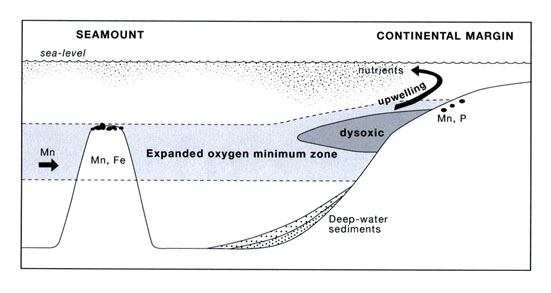Mn Genesis
Manganese ores in Europe tend to be in small deposits, totalling only 55 million tonnes, mostly at Urkut. However, they are usually well-studied. As a consequence they provide a valuable density of data.
These deposits show a strong concentration in time at 180 Ma, Early Toarcian. This Toarcian event has been associated with upwelling and an expansion of the oxygen minimum zone (Jenkyns et al., 1991; but see Newton and Bottrell, 2007, for a review of alternate explanations).

More extensive reducing conditions on the seafloor, caused by enhanced surface-water productivity, could cause mobilization of Mn oxides from deep-water sediments into the mid-water column, and their transfer to shallow-water sediments where the upper boundary of the oxygen minimum zone intersects the seafloor (Figure). At this position, Mn2+ can be re-oxidized to insoluble Mn oxide, which falls to the bottom where it is converted to Mn carbonate during early diagenetic reaction with organic matter (Calvert and Peterson, 1996).
It is likely that phosphate-enriched Mn deposits form in this way. The Toarcian deposits are all small except for Urkút in Hungary (Polgári et al., 2003), which may have been augmented by hydrothermal sources (Jenkyns et al., 1991; Lantos et al., 2003). There is a comparable Cenomanian-Turonian event that produced Mn enrichment in limestones (Pratt et al., 1991; Dickens and Owen, 1993), but only two small economic deposits, Spława in Poland and Ulukent-Gökçeovacik in Turkey. Thus, major periods of oceanic upwelling are associated with Mn anomalies, but only in exceptional cases with significant orebodies.